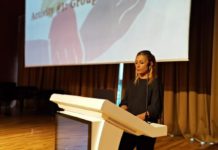‘SALTWATER/TUZLU SU: A Theory on Thought Forms’ is the theme for the 14th Istanbul Biennial drafted by Carolyn Christov-Bakargiev. In a city deeply saturated in history and full of secret spaces, this Biennial is the perfect blend of art and adventure. It encourages us to get out, explore our surroundings and go on an artistic expedition full of many new discoveries. I myself took an excursion to Büyükada (Big Island) to check out the art and see what this Biennial experience outside the city had to offer.

My journey began by fending off a swarm of selfie sticks and trying to drown out the garçon’s repetitive “çay…vaov, vaov, vaov, vaov, vaov!” on the ferry. Just a little over an hour and I had made it to my destination. It was nice to be surrounded by trees, the sea and decadent mansions without the obnoxious roar of vehicles – a big change from life in the city center. But more importantly, there was art to see. There are a total of seven Biennial venues on the island, many of which are usually off limits to the public so now’s a good time to explore these spaces and the art within them.

Fresh off the boat, I hopped over to the next dock over and entered the Kaptan Paşa Sea Bus through a winding portal made of wooden bits and pieces. The boat’s darkened interior is covered in felt from ceiling to floor, and in the center of the room is an overturned fishing boat. There are spaces between the planks of the fishing boat that allow the viewer to peer inside, where metal plates covered with salt move by sound vibrations. Like the laboratory of a mad sea captain, Marco Lutyen’s Neurathian Boatstrap left me wondering what lies beneath. Around back on the upper deck, Pınar Yoldaş’s Saltwater Heart embraces both land and sea. This fluid structure made me think of all things living under the sea and our disconnection from them.

Back on land, I made my way up Nisan Caddesi to the Büyükada Public Library where I grabbed a map of the venues and begin my proper tour de arte. The library also serves as a venue for artist Merve Kılıçer’s piece Mater.ial, which is displayed on the second floor. I was drawn to the golden bouquet of thistle wrapped in gauze, which hangs upside down over a handmade copper table. The main focus of this piece, though, are the two books displayed on the table; each is full of colorful prints inspired by the creation myths of Tiamet and Innana, two Sumerian goddesses.

Traveling down the path to the magnificent Splendid Palace Hotel, I let my mind wander imagining what it might have been like to kick back with Trotsky over an afternoon cocktail and catch up on all the island gossip. Why was Trotsky on my mind? Well, the Splendid Palace Hotel is housing William Kentridge’s video installation O Sentimental Machine, a tribute to Leon Trotsky that focuses on the time he spent on the island living in exile and his means of communication with the world via his secretary. The context of this piece definitely put me in a nostalgic mood.


Opposite the main drag, I hung a left onto Kadıyoran Caddesi which took me up to the Rizzo Palace, a dark, ominous structure tucked amongst the pines. Following the sound of music down to the basement there turned out to be only a speaker in the darkness. Upstairs, Ed Atkins’s video Hisser (his adaption based on the true story of a man’s final hours before his house is swallowed by a sinkhole) played on a giant rectangular screen that rested on the floor. I was too distracted by the invitation of open doors surrounding the room and by people constantly passing back and forth. It seems they were far more curious about the space rather than the work itself, and it turns out I was also one of those people.

The next stop was the Mizzi Mansion with its vibrant exterior and spectacular front garden. Although the space inside was empty, aside from a few large black and white photos scattered about, the presence of Suzan Philipsz’s sound installation Elettra gave me goosebumps. The ambient sounds recorded underwater penetrated my subconscious, and I felt I was scanning the rooms in search of something that I could not find. This feeling was heightened by the fact that the rooms on the main floor are only accessible by peeking inside, which ensures that a sense of mystery remains.

Moving onto Çankaya 57, a bunch of us packed inside a small room to watch Daria Martin’s new 16mm film At the Threshold. I liked this film because she based it on people’s actual experiences about feeling what others feel.

Then came the most exciting part of the journey… Navigating my way through the jungle that surrounds the slowly crumbling Trotsky house, I wandered down the winding path that led to the sea where I witnessed a magical sight: a small army of life-size animals staged along the shore. These whimsical creatures, born from the imagination of Argentinian artist Adrian Villar Rojas, are partially consumed by a variety of materials such as rope, feathers, stone, wood, sticks and even watermelon. The installation, entitled The Most Beautiful of All Mothers, definitely takes the gold out of the Biennial exhibitions on the island.


After a full day of parading through abandoned houses and passing time near the water’s edge, I made my way back to the iskele before my ship rolled in. Here the crowds were gnawing away at ice cream cones the size of a child’s arm and documenting what they were about to consume.

I encourage all selfie sticks to be left at home so that you can spend a day on the island soaking up the art instead of yourself.
The 14th edition of the Istanbul Biennial runs through November 1st. For more information click here.
Featured Image Source: M. Patterson
Marga Patterson is a contributor to Yabangee.










Very impressive Marga!
Wow after reading this I felt like I was seeing the exhibit with my own eyes, like I was really there. M. Patterson true explorer of one’s soul you can see it in the Turkish sky.
Glistening.
[…] This post was first published here. […]